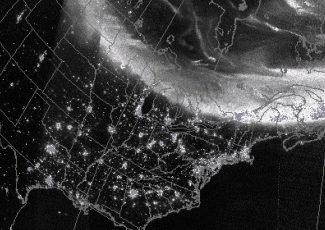Sorry Starry Night

An
individual conducted a science experiment that measured the impact of  on the sky above an adjacent
neighborhood. On five clear nights
between March 2006 and December 2006, she measured the sky glow at seven
sites
on the sky above an adjacent
neighborhood. On five clear nights
between March 2006 and December 2006, she measured the sky glow at seven
sites using two Sky Quality Meters (SQMs).
using two Sky Quality Meters (SQMs).
 The experiment spanned the time from when the 30-acre development was
just an open field
The experiment spanned the time from when the 30-acre development was
just an open field  to when it was partially developed and open for business
to when it was partially developed and open for business ,
during which time there were significant increases in its outdoor lighting.
,
during which time there were significant increases in its outdoor lighting.
At
each of the seven sites she typically recorded ten readings with one SQM and
five readings with a second SQM through the car's sunroof.
Overall she recorded 480 SQM readings and entered her results in a
database. Sometimes she copied a
local Clear Sky Clock
![]() to confirm that the sky was without celestial interference (e.g., full moon)
during her observations. On December
14, by serendipity the student briefly witnessed the concurrent aurora
to confirm that the sky was without celestial interference (e.g., full moon)
during her observations. On December
14, by serendipity the student briefly witnessed the concurrent aurora
 and Geminid meteor shower.
and Geminid meteor shower.
She tried to control as many variables as possible. For example, she only went out after astronomical twilight, when the sun contributed no light to the sky glow; she went out when the moon was either absent or well below the SQM’s 80-degree cone of detection; and she was consistent with where and how she took her observations.
Later
she drew graphs by hand
that showed the SQM reading numbers on the x-axis versus
the SQM units on the y-axis. She
correlated the curves of the two meters on a graph to see if her meters were
consistent with each other. She also
averaged her SQM readings and plotted a generally descending
slope,
 which suggested an increase in the measured sky glow.
which suggested an increase in the measured sky glow.
While she concluded some of the increased sky glow from March to December was from the new shopping center adjacent to her neighborhood sites, she also attributed some of the increase to holiday lights. After all, she noted, late November was exceptionally mild, so many more lights than normal seemed to affect the sky. The student wrote that if she were to do it again she would increase the number of observation sites; take greater advantage of clear nights to get more readings; and increase the number of meters used at each site.
To
convey the impact of excessive outdoor lighting, she named her project Sorry
Starry Night. For a visual
impression, she displayed one picture of Vincent van
Gogh’s original masterpiece  next to a second picture that she modified on a computer.
Her version of Starry Night
next to a second picture that she modified on a computer.
Her version of Starry Night
 showed the new retail development on top of van Gogh’s
village, and a yellow, light-polluted sky degraded his original blue swirls.
Later she shared her findings
showed the new retail development on top of van Gogh’s
village, and a yellow, light-polluted sky degraded his original blue swirls.
Later she shared her findings  with
the local amateur astronomy community
with
the local amateur astronomy community  and at the regional science fair.
and at the regional science fair.
 she created two years prior.
That activity, called Light Here, Light There, showed the positive outcomes from shielding
outdoor lights
she created two years prior.
That activity, called Light Here, Light There, showed the positive outcomes from shielding
outdoor lights